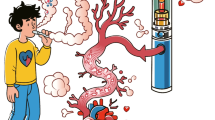Summary
Short-term cultures of human lymphocytes were used to investigate the in vitro metabolism of benzene and its genotoxicity, and to monitor genetic health effects of lifestyles. Metabolic (S9) activation of benzene and its metabolites, catechol, hydroquinone, and phenol, caused an increase in sister-chromatid exchanges (SCEs) with different optimal concentrations of S9 mix for converting each compound into further reactive forms. The data indicate that catechol and hydroquinone can be optimally metabolized to produce reactive species, presumably benzo(semi)quinones, under conditions of lower metabolic activity than those necessary for phenol and benzene. We have further investigated the correlations between chromosome alterations (SCEs, structural aberrations and micronuclei) in peripheral lymphocytes and individual lifestyles. Healthy lifestyles, or “good health practices” examined were 1) not smoking, 2) not drinking too much alcohol, 3) doing physical exercise regularly, 4) sleeping more than 6 h per night, 5) keeping nutritional balance in meals, 6) not snacking, 7) having breakfast everyday, and 8) not having too much perceived stress. The persons were categorized into 3 groups having good, moderate and poor lifestyles by the number of good health practices they do. Mean frequencies of chromosome alterations in lymphocytes from men with poor lifestyles have been shown to be significantly higher than those in cells from men having good lifestyles. Further experiments have been done to examine whether lymphocytes from men having unhealthy lifestyles might show a higher susceptibility 1) to the SCE production by treatment with hydroquinone, a major metabolite of benzene, and 2) to the chemical's inhibitory effect of repair of radiation-induced chromosome breakage, because our living and working environments contain possible repair inhibitors such as benzene, lead and chromium. The results showed that unhealthy lifestyles could make the cells to be more sensitive to the production of these chromosome alterations by the environmental and occupational agents.
Similar content being viewed by others
References
Berkman LF, Breslow L (1983) Health and ways of living; The Alameda County Study. Oxford University Press, New York
Carins J (1981) The origin of human cancers. Nature 289:353–357
Dean BJ (1978) Genetic toxicology of benzene, toluene, xylene and phenols. Mutat Res 47:75–97
Hagihara A, Morimoto K (1991) Personal health practices and attitudes toward non-smoker's rights in Japan. Soc Sci Med 33:717–721
Irons RD, Dent JG, Baker TS, Rickert DE (1980) Benzene is metabolized and covalently bound in bone marrow in situ. Chem Biol Interact 30:241–245
Klein G (1981) The role of gene dosage and genetic transpositions in carcinogenesis. Nature 294:313–318
Kusaka, Y, Kondo H, Morimoto, K (1992) Healthy lifestyles are associated with higher natural killer cell activity. Prev Med 21:602–615
Morimoto K (1975) Inhibition of repair of radiation-induced chromosome breaks: effect of benzene in cultured human lymphocytes. Jpn J Ind Health 17:166–167
Morimoto K (1976) Analysis of combined effects of benzene with radiation on chromosomes in cultured human leukocytes. Jpn J Ind Health 18:23–34
Morimoto K, Koizumi A, Tachibana Y, Dobashi Y (1976) Inhibition of repair of radiation-induced chromosome breaks; effect of phenol in cultured human lymphocytes. Jpn J Ind Health 18:478–479
Morimoto K, Wolff S (1980a) Increase of sister chromatid exchanges and perturbations of cell division kinetics in human lymphocytes by benzene metabolites. Cancer Res 40:1189–1193
Morimoto K, Wolff S (1980b) Cell cycle kinetics in human lymphocyte cultures. Nature (Lond.) 288:604–606
Morimoto K (1983) Induction of sister-chromatid exchanges and cell division delays in human lymphocytes by microsomal activation of benzene. Cancer Res 43:1330–1334
Morimoto K (1986) Life-styles and health situations: Importance of genetic health and quality of life; position paper for the workshop on social learning and coping options, WHO Document of the International Conference on Health Promotion, WHO/EURO Office, Copenhagen
Morimoto K (1990) Life-style and genetic factors that determine the susceptibility to production of chromosome damage. Obe G, Natarajan AT (eds) Chromosomal aberrations: Basic and applied aspects, Springer-Verlag, Berlin, 287–301
Morimoto K, Kitamura M, Kondo H, Koizumi A (1986) Genotoxicity of diesel exhaust emissions in a battery of in vitro short-term and in vivo bioassays. Ishinishi N, Koizumi A, McClellan RO, Stöer E (eds) Carcinogenic and mutagenic effects of diesel engine exhaust, Elsevier, Amsterdam
Ohno Y, Spriggs D, Matsukage A, Ohno T and Kufe D (1988) Effects of 1-b-D-arabinofuranosylcytosine Incorporation on Elongation of Specific DNA Sequences by DNA Polymerise b. Cancer Res 48:1494–1498
Preston, RJ (1980) The Effect of Cytosine Anabinoside on the Frequency of X-ray-induced Chromosome Aberrations in Normal Human Lymphocytes. Mutation Res 69:71–79
Rickert DE, Baker TS, Bus JS, Barrow CS, Irons RD (1979) Benzene disposition in the rat after exposure by inhalation. Toxicol Appl Pharmacol 49:417–423
Snyder R, Lee EW, Kocsis JJ (1978) Binding of labeled benzene metabolites to mouse liver and bone marrow. Res Commun Chem Pathol Pharmacol 20:191–194
Tunek A, Platt KL, Bentley P, Oesch F (1978) Microsomal metabolism of benzene to species irreversibly binding to microsomal protein and effects of modifications of this metabolism. Mol Pharmacol 14:920–929
Tunek A, Platt KL, Przbylski M, Oesch F (1980) Multi-step metabolic activation of benzene, Effect of superoxide dismutase on covalent binding to microsomal macromolecules, and identification of glutathione conjugates using high pressure liquid chromatography and field desorption mass spectrometry. Chem Biol Interact 33:1–17
Author information
Authors and Affiliations
Rights and permissions
About this article
Cite this article
Morimoto, K., Takeshita, T., Take-uchi, T. et al. Chromosome alterations in peripheral lymphocytes as indices of lifestyle and genotoxicity. Int. Arch Occup Environ Heath 65 (Suppl 1), S37–S41 (1993). https://doi.org/10.1007/BF00381305
Issue Date:
DOI: https://doi.org/10.1007/BF00381305




